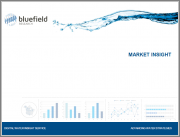
|
시장보고서
상품코드
1616035
건설용 웨어러블 기술 시장 : 시장 성장 기회, 성장 촉진요인, 산업 동향 분석, 예측(2024-2032년)Construction Wearable Technology Market Opportunity, Growth Drivers, Industry Trend Analysis, and Forecast 2024 - 2032 |
||||||
세계의 건설용 웨어러블 기술 시장은 2023년에 41억 달러로 평가되었고, 2024년부터 2032년까지 10%의 연평균 복합 성장률(CAGR)이 예측되고 있습니다.
건설 부문은 그 위험한 성질로 악명 높고, 노동재해나 사망 사고 발생률의 상승에 시달리고 있습니다. 웨어러블 기술은 위험한 상태를 식별하면서 바이탈 사인의 실시간 모니터링을 용이하게 하고 잠재적 위협을 작업자와 감독자 모두에게 신속하게 경고함으로써 작업자의 안전을 강화합니다. 게다가 이러한 웨어러블은 전도, 갑작스러운 건강 위기 또는 위험한 환경에 노출되는 등의 시나리오로 경고를 자율적으로 발신하여 긴급 대응을 신속화할 수 있습니다.
웨어러블은 감독자에게 잠재적인 문제에 대한 조기 경고를 제공하고 적극적인 유지 보수를 위한 길을 열고 장비 고장과 작업자의 근무로 인한 가동 중지 시간을 최소화합니다. 웨어러블 기술을 활용함으로써 건설사는 경쟁 벤치마킹을 강화할 뿐만 아니라 생산성 벤치마킹도 향상시킬 수 있습니다. 또한 이러한 장치는 실시간 최신 정보와 신속한 문제 대응을 제공하기 위해 팀의 커뮤니케이션을 강화합니다. 이러한 진보는 보다 효율적이고 안전한 프로젝트 완료로 결실을 맺어 전체적인 성공률을 끌어올립니다.
| 시장 범위 | |
|---|---|
| 시작년 | 2023년 |
| 예측년 | 2024-2032년 |
| 시작 가격 | 41억 달러 |
| 예상 가격 | 96억 달러 |
| CAGR | 10% |
스마트 헬멧 부문은 2023년에 약 30%의 점유율을 차지했습니다. 이러한 헬멧은 충격 감지, 실시간 위험 통지, 환경 모니터링 등의 센서 및 기술을 자랑합니다. 이러한 기능은 작업원을 사고로부터 지킬 뿐만 아니라, 스마트 헬멧이 건설 현장에서 제공하는 적극적인 안전 관리를 강조해, 보급에 박차를 가하고 있습니다. 북미의 건설용 웨어러블 기술 시장은 2023년 39%의 점유율을 차지했고, 2032년까지 현저한 확대가 예상되고 있습니다. 북미의 건설 산업은, 다양한 부문에서 최첨단 기술을 신속하게 도입하고 있는 것으로 알려져 있어, 웨어러블 기술을 BIM(빌딩 인포메이션 모델링)이나 IoT 등의 디지털 툴과 원활하게 융합시키고 있습니다. 이 통합은 효율성, 안전성, 프로젝트 감독을 강화하는 것을 목적으로 하고 있습니다.
목차
제1장 조사 방법 및 조사 범위
제2장 주요 요약
제3장 산업 인사이트
- 생태계 분석
- 공급자의 상황
- 원료 및 부품 공급자
- 기술 제공업체
- 하드웨어 제조업체
- 시스템 통합자
- 최종 사용자
- 이익률 분석
- 기술과 혁신의 전망
- 가격 분석
- 특허 분석
- 주요 뉴스 및 이니셔티브
- 제휴 및 협력
- 합병 및 인수
- 투자
- 제품 출시 및 혁신
- 규제 상황
- 영향요인
- 성장 촉진요인
- 근로자의 안전과 규제 준수의 중시가 증가
- 건설 산업에서의 IoT와 스마트 기술의 채용 확대
- 생산성 향상을 위한 실시간 데이터와 분석에 대한 수요 증가
- 센서와 통신 기기의 기술적 진보
- 산업의 잠재적 리스크 및 과제
- 높은 도입 및 유지 보수 비용
- 잠재적인 개인정보 보호 및 데이터 보안 문제
- 성장 촉진요인
- 성장 가능성 분석
- Porter's Five Forces 분석
- PESTEL 분석
제4장 경쟁 구도
- 서문
- 기업 점유율 분석
- 경쟁 포지셔닝 매트릭스
- 전략 전망 매트릭스
제5장 시장 추정 및 예측 : 제품별(2021-2032년)
- 주요 동향
- 워치
- 부츠
- 스마트 헬멧
- 스마트 글라스
- 바디웨어 및 베스트
- 외골격
- 기타
제6장 시장 추정 및 예측 : 접속성 기술별(2021-2032년)
- 주요 동향
- Bluetooth
- Wi Fi
- 4G 및 5G
- RFID/NFC
제7장 시장 추정 및 예측 : 용도별(2021-2032년)
- 주요 동향
- 근로자의 안전
- 생산성 모니터링
- 통신
- 건강 모니터링
- 트레이닝과 시뮬레이션
제8장 시장 추정 및 예측 : 최종 사용자별(2021-2032년)
- 주요 동향
- 주택용
- 상업용
- 산업용
- 인프라
- 기타
제9장 시장 추정 및 예측 : 지역별(2021-2032년)
- 주요 동향
- 북미
- 미국
- 캐나다
- 유럽
- 영국
- 독일
- 프랑스
- 이탈리아
- 스페인
- 러시아
- 북유럽
- 기타 유럽
- 아시아태평양
- 중국
- 인도
- 일본
- 한국
- 뉴질랜드
- 동남아시아
- 기타 아시아태평양
- 라틴아메리카
- 브라질
- 멕시코
- 아르헨티나
- 기타 라틴아메리카
- 중동 및 아프리카
- 남아프리카
- 아랍에미리트(UAE)
- 사우디아라비아
- 기타 중동 및 아프리카
제10장 기업 프로파일
- ABB
- Apple
- ARM Limited
- Ekso Bionics
- Garmin
- German Bionic Systems GmbH
- Halo Technologies
- Honeywell International Inc.
- Kenzen
- Motorola Solutions
- Oculus
- Panasonic
- RealWear Inc.
- Siemens
- Triax Technologies
- Trimble Inc.
- United Technologies
- Wearable Intelligence
- XREAL, Inc.
- Zebra Technologies
The Global Construction Wearable Technology Market was valued at USD 4.1 billion in 2023, and projections indicate a 10% CAGR from 2024 to 2032, primarily driven by an intensified emphasis on worker safety. The construction sector, notorious for its perilous nature, grapples with elevated rates of workplace injuries and fatalities. Wearable technology bolsters worker safety by facilitating real-time monitoring of vital signs while identifying hazardous conditions, and promptly alerting both workers and supervisors to potential threats. Furthermore, these wearables can autonomously dispatch alerts in scenarios like falls, sudden health crises, or exposure to perilous environments, thereby expediting emergency responses.
Wearables empower supervisors with early warnings about potential issues, paving the way for proactive maintenance and minimizing downtime, whether due to equipment malfunctions or worker absences. By harnessing wearable technology, construction firms not only bolster their competitiveness but also elevate their productivity benchmarks. Additionally, these devices enhance team communication for offering real-time updates and swift issue responses. Such advancements culminate in more efficient and safer project completions, boosting overall success rates.
The overall industry is divided into product, connectivity technology, application and end-user, and region. The worker safety application dominated the market with over 40% share in 2023, projecting to surpass USD 3.4 billion by 2032. Globally, governments and regulatory entities are amplifying their focus on workplace safety, especially in high-risk sectors like construction. Regulations, such as OSHA in the U.S. and counterparts in Europe and Asia, impose stringent safety standards on construction sites. Such regulatory mandates propel the adoption of wearable technologies, which monitor worker health, identify dangers, and issue real-time alerts to avert accidents.
| Market Scope | |
|---|---|
| Start Year | 2023 |
| Forecast Year | 2024-2032 |
| Start Value | $4.1 Billion |
| Forecast Value | $9.6 Billion |
| CAGR | 10% |
The smart helmet segment accounted for approximately 30% share in 2023. These helmets boast an array of sensors and technologies, including impact detection, real-time hazard notifications, and environmental monitoring. Such features not only shield workers from accidents but also underscore the proactive safety management that smart helmets offer on construction sites, fueling their widespread adoption. North America construction wearable technology market commanded a substantial 39% share in 2023, with expectations of notable expansion through 2032. Renowned for its swift adoption of cutting-edge technologies across various sectors, North America construction industry is seamlessly weaving wearable technology with digital tools like Building Information Modeling (BIM) and IoT. This integration aims to bolster efficiency, safety, and project oversight.
Table of Contents
Chapter 1 Methodology & Scope
- 1.1 Research design
- 1.1.1 Research approach
- 1.1.2 Data collection methods
- 1.2 Base estimates and calculations
- 1.2.1 Base year calculation
- 1.2.2 Key trends for market estimates
- 1.3 Forecast model
- 1.4 Primary research & validation
- 1.4.1 Primary sources
- 1.4.2 Data mining sources
- 1.5 Market definitions
Chapter 2 Executive Summary
- 2.1 Market 360° synopsis, 2021 - 2032
Chapter 3 Industry Insights
- 3.1 Industry ecosystem analysis
- 3.2 Supplier landscape
- 3.2.1 Raw material & component suppliers
- 3.2.2 Technology providers
- 3.2.3 Hardware manufacturers
- 3.2.4 System integrators
- 3.2.5 End users
- 3.3 Profit margin analysis
- 3.4 Technology & innovation landscape
- 3.5 Pricing analysis
- 3.6 Patent analysis
- 3.7 Key news and initiatives
- 3.7.1 Partnership/Collaboration
- 3.7.2 Merger/Acquisition
- 3.7.3 Investment
- 3.7.4 Product launch & innovation
- 3.8 Regulatory landscape
- 3.9 Impact forces
- 3.9.1 Growth drivers
- 3.9.1.1 Increasing emphasis on worker safety and regulatory compliance
- 3.9.1.2 Growing adoption of IoT and smart technology in construction
- 3.9.1.3 Rising demand for real-time data and analytics to enhance productivity
- 3.9.1.4 Technological advancements in sensors and communication devices
- 3.9.2 Industry pitfalls & challenges
- 3.9.2.1 High cost of implementation and maintenance
- 3.9.2.2 Potential privacy concerns and data security issues
- 3.9.1 Growth drivers
- 3.10 Growth potential analysis
- 3.11 Porter's analysis
- 3.12 PESTEL analysis
Chapter 4 Competitive Landscape, 2023
- 4.1 Introduction
- 4.2 Company market share analysis
- 4.3 Competitive positioning matrix
- 4.4 Strategic outlook matrix
Chapter 5 Market Estimates & Forecast, By Product, 2021-2032 ($Bn, Units)
- 5.1 Key trends
- 5.2 Watch
- 5.3 Boot
- 5.4 Smart helmet
- 5.5 Smart glasses
- 5.6 Body wear/vest
- 5.7 Exoskeleton
- 5.8 Others
Chapter 6 Market Estimates & Forecast, By Connectivity Technology, 2021-2032 ($Bn, Units)
- 6.1 Key trends
- 6.2 Bluetooth
- 6.3 Wi Fi
- 6.4 4G/5G
- 6.5 RFID/NFC
Chapter 7 Market Estimates & Forecast, By Application, 2021-2032 ($Bn, Units)
- 7.1 Key trends
- 7.2 Worker safety
- 7.3 Productivity monitoring
- 7.4 Communication
- 7.5 Health monitoring
- 7.6 Training & simulation
Chapter 8 Market Estimates & Forecast, By End-User, 2021-2032 ($Bn, Units)
- 8.1 Key trends
- 8.2 Residential
- 8.3 Commercial
- 8.4 Industrial
- 8.5 Infrastructure
- 8.6 Others
Chapter 9 Market Estimates & Forecast, By Region, 2021-2032 ($Bn, Units)
- 9.1 Key trends
- 9.2 North America
- 9.2.1 U.S.
- 9.2.2 Canada
- 9.3 Europe
- 9.3.1 UK
- 9.3.2 Germany
- 9.3.3 France
- 9.3.4 Italy
- 9.3.5 Spain
- 9.3.6 Russia
- 9.3.7 Nordics
- 9.3.8 Rest of Europe
- 9.4 Asia Pacific
- 9.4.1 China
- 9.4.2 India
- 9.4.3 Japan
- 9.4.4 South Korea
- 9.4.5 ANZ
- 9.4.6 Southeast Asia
- 9.4.7 Rest of Asia Pacific
- 9.5 Latin America
- 9.5.1 Brazil
- 9.5.2 Mexico
- 9.5.3 Argentina
- 9.5.4 Rest of Latin America
- 9.6 MEA
- 9.6.1 South Africa
- 9.6.2 UAE
- 9.6.3 Saudi Arabia
- 9.6.4 Rest of MEA
Chapter 10 Company Profiles
- 10.1 ABB
- 10.2 Apple
- 10.3 ARM Limited
- 10.4 Ekso Bionics
- 10.5 Garmin
- 10.6 German Bionic Systems GmbH
- 10.7 Halo Technologies
- 10.8 Honeywell International Inc.
- 10.9 Kenzen
- 10.10 Motorola Solutions
- 10.11 Oculus
- 10.12 Panasonic
- 10.13 RealWear Inc.
- 10.14 Siemens
- 10.15 Triax Technologies
- 10.16 Trimble Inc.
- 10.17 United Technologies
- 10.18 Wearable Intelligence
- 10.19 XREAL, Inc.
- 10.20 Zebra Technologies

















